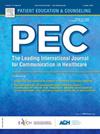Influence of patient-oriented organizational climate on physicians’ patient-centered behavior: The mediating role of patient-centeredness self-efficacy
IF 2.9
2区 医学
Q2 PUBLIC, ENVIRONMENTAL & OCCUPATIONAL HEALTH
引用次数: 0
Abstract
Objective
Existing literature highlights the benefits of organizational climate, but research gaps exist regarding how a patient-oriented organizational climate captures the sub-dimensions of physicians’ patient-centered behavior. We explored the mediating role of patient-centeredness self-efficacy between them.
Methods
Utilizing the Patient-Oriented Organizational Climate Scale, Self-efficacy in Patient-Centeredness Questionnaire, and Doctor Interaction Behavior Evaluation Scale, we surveyed 1394 physicians from grade ⅢA general hospitals in Guangdong Province, China from July to September 2022, employing stratified proportional sampling.
Results
Patient-oriented organizational climate was positively associated with patient-centered behavior. Patient-centeredness self-efficacy partially mediated their relationship, with varying effects on different dimensions of patient-centered behavior; further, it could partially mediate the association between patient-oriented organizational climate and dialogue and transparency dimensions, but played a full mediating role between patient-oriented organizational climate and access and risk assessment dimensions.
Conclusion
These findings underscore the importance of establishing a patient-oriented organizational climate and fostering patient-centeredness self-efficacy in shaping patient-centered behavior, as they differ in impact on the dimensions of patient-centered behavior.
Practice Implications
Targeted interventions are necessary to clarify the definitions of patient-centered behavior and consider it as a multidimensional construct.
以患者为中心的组织氛围对医生以患者为中心行为的影响:以患者为中心的自我效能感的中介作用
目的现有文献强调了组织氛围的好处,但在以患者为导向的组织氛围如何捕捉医生以患者为中心行为的子维度方面存在研究空白。探讨以病人为中心的自我效能感在两者之间的中介作用。方法采用分层比例抽样方法,于2022年7 - 9月对广东省Ⅲ甲等综合医院1394名医师进行问卷调查,采用以患者为中心的组织氛围量表、以患者为中心的自我效能感问卷和医生互动行为评价量表。结果以患者为中心的组织氛围与以患者为中心的行为呈正相关。以患者为中心的自我效能感部分介导了二者之间的关系,但在以患者为中心的行为的不同维度上有不同的影响;以患者为导向的组织氛围对对话和透明度维度具有部分中介作用,但在以患者为导向的组织氛围对准入和风险评估维度具有完全中介作用。结论建立以患者为中心的组织氛围和培养以患者为中心的自我效能感对塑造以患者为中心的行为具有重要意义,因为它们对以患者为中心的行为维度的影响不同。实践意义有针对性的干预是必要的,以澄清以患者为中心的行为的定义,并将其视为一个多维结构。
本文章由计算机程序翻译,如有差异,请以英文原文为准。
求助全文
约1分钟内获得全文
求助全文
来源期刊

Patient Education and Counseling
医学-公共卫生、环境卫生与职业卫生
CiteScore
5.60
自引率
11.40%
发文量
384
审稿时长
46 days
期刊介绍:
Patient Education and Counseling is an interdisciplinary, international journal for patient education and health promotion researchers, managers and clinicians. The journal seeks to explore and elucidate the educational, counseling and communication models in health care. Its aim is to provide a forum for fundamental as well as applied research, and to promote the study of organizational issues involved with the delivery of patient education, counseling, health promotion services and training models in improving communication between providers and patients.
 求助内容:
求助内容: 应助结果提醒方式:
应助结果提醒方式:


